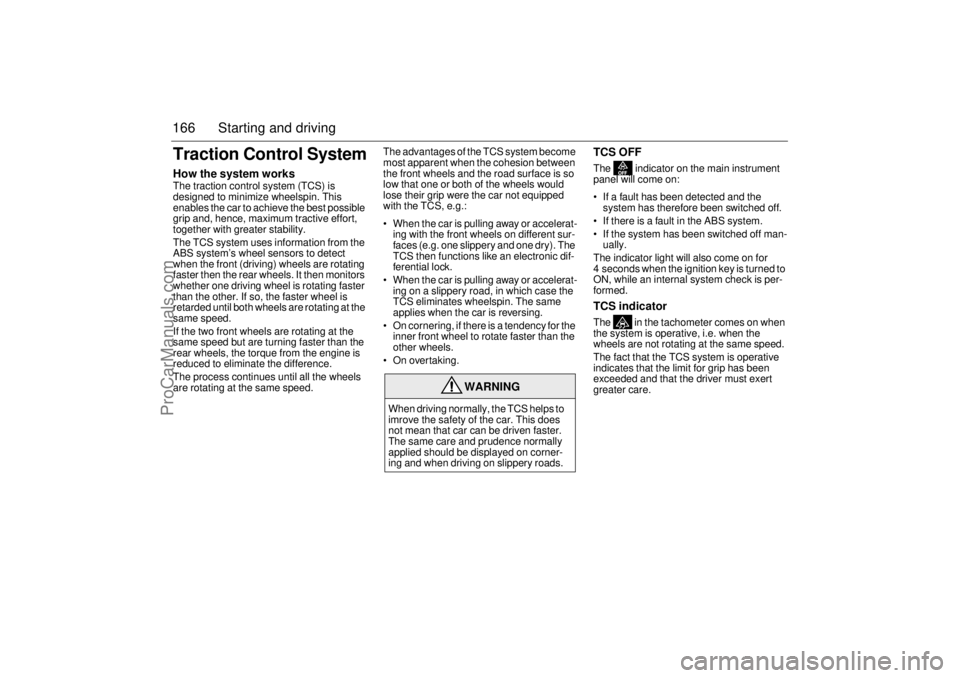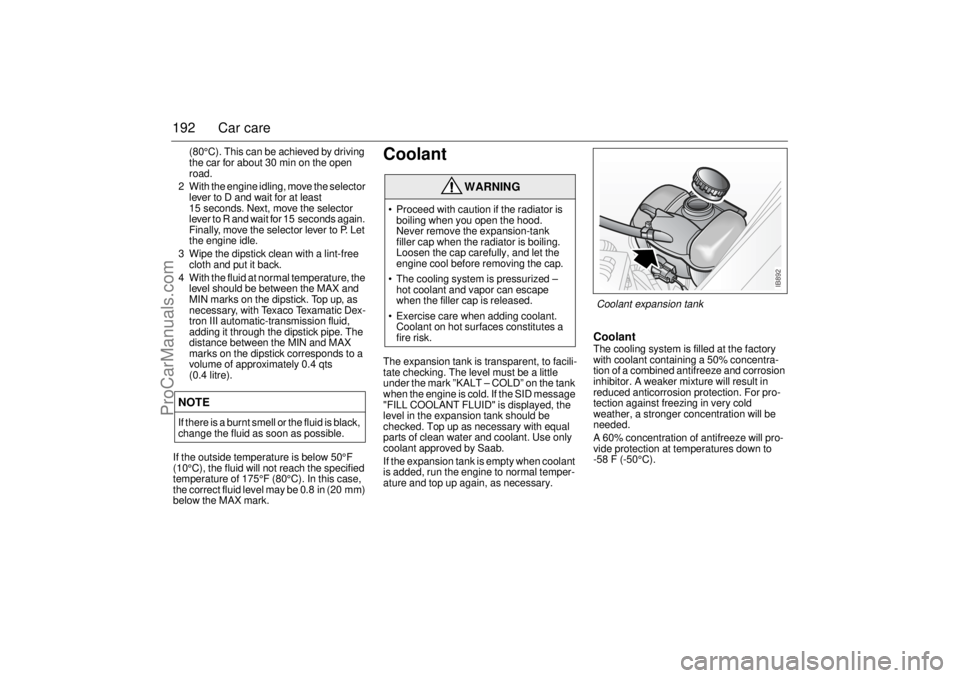display SAAB 9-3 2002 Owner's Guide
[x] Cancel search | Manufacturer: SAAB, Model Year: 2002, Model line: 9-3, Model: SAAB 9-3 2002Pages: 256, PDF Size: 11.55 MB
Page 166 of 256

166 Starting and drivingTraction Control SystemHow the system works The traction control system (TCS) is
designed to minimize wheelspin. This
enables the car to achieve the best possible
grip and, hence, maximum tractive effort,
together with greater stability.
The TCS system uses information from the
ABS system’s wheel sensors to detect
when the front (driving) wheels are rotating
faster then the rear wheels. It then monitors
whether one driving wheel is rotating faster
than the other. If so, the faster wheel is
retarded until both wheels are rotating at the
same speed.
If the two front wheels are rotating at the
same speed but are turning faster than the
rear wheels, the torque from the engine is
reduced to eliminate the difference.
The process continues until all the wheels
are rotating at the same speed. The advantages of the TCS system become
most apparent when the cohesion between
the front wheels and the road surface is so
low that one or both of the wheels would
lose their grip were the car not equipped
with the TCS, e.g.:
When the car is pulling away or accelerat-
ing with the front wheels on different sur-
faces (e.g. one slippery and one dry). The
TCS then functions like an electronic dif-
ferential lock.
When the car is pulling away or accelerat-
ing on a slippery road, in which case the
TCS eliminates wheelspin. The same
applies when the car is reversing.
On cornering, if there is a tendency for the
inner front wheel to rotate faster than the
other wheels.
On overtaking.
TCS OFF The indicator on the main instrument
panel will come on:
If a fault has been detected and the
system has therefore been switched off.
If there is a fault in the ABS system.
If the system has been switched off man-
ually.
The indicator light will also come on for
4 seconds when the ignition key is turned to
ON, while an internal system check is per-
formed. TCS indicator The in the tachometer comes on when
the system is operative, i.e. when the
wheels are not rotating at the same speed.
The fact that the TCS system is operative
indicates that the limit for grip has been
exceeded and that the driver must exert
greater care.
WARNING
When driving normally, the TCS helps to
imrove the safety of the car. This does
not mean that car can be driven faster.
The same care and prudence normally
applied should be displayed on corner-
ing and when driving on slippery roads.
ProCarManuals.com
Page 192 of 256

192 Car care
(80°C). This can be achieved by driving
the car for about 30 min on the open
road.
2 With the engine idling, move the selector
lever to D and wait for at least
15 seconds. Next, move the selector
lever to R and wait for 15 seconds again.
Finally, move the selector lever to P. Let
the engine idle.
3 Wipe the dipstick clean with a lint-free
cloth and put it back.
4 With the fluid at normal temperature, the
level should be between the MAX and
MIN marks on the dipstick. Top up, as
necessary, with Texaco Texamatic Dex-
tron III automatic-transmission fluid,
adding it through the dipstick pipe. The
distance between the MIN and MAX
marks on the dipstick corresponds to a
volume of approximately 0.4 qts
(0.4 litre).
If the outside temperature is below 50°F
(10°C), the fluid will not reach the specified
temperature of 175°F (80°C). In this case,
the correct fluid level may be 0.8 in (20 mm)
below the MAX mark.
CoolantThe expansion tank is transparent, to facili-
tate checking. The level must be a little
under the mark ”KALT – COLD” on the tank
when the engine is cold. If the SID message
"FILL COOLANT FLUID" is displayed, the
level in the expansion tank should be
checked. Top up as necessary with equal
parts of clean water and coolant. Use only
coolant approved by Saab.
If the expansion tank is empty when coolant
is added, run the engine to normal temper-
ature and top up again, as necessary.
Coolant The cooling system is filled at the factory
with coolant containing a 50% concentra-
tion of a combined antifreeze and corrosion
inhibitor. A weaker mixture will result in
reduced anticorrosion protection. For pro-
tection against freezing in very cold
weather, a stronger concentration will be
needed.
A 60% concentration of antifreeze will pro-
vide protection at temperatures down to
-58 F (-50°C).
NOTEIf there is a burnt smell or the fluid is black,
change the fluid as soon as possible.
WARNING
Proceed with caution if the radiator is
boiling when you open the hood.
Never remove the expansion-tank
filler cap when the radiator is boiling.
Loosen the cap carefully, and let the
engine cool before removing the cap.
The cooling system is pressurized –
hot coolant and vapor can escape
when the filler cap is released.
Exercise care when adding coolant.
Coolant on hot surfaces constitutes a
fire risk.
IB892
Coolant expansion tank
ProCarManuals.com
Page 245 of 256

245 Technical data
Several of the systems in your Saab
car may be adjusted to better fit your
individual needsSome functions are governed by legal
requirements and cannot therefore be
reprogrammed.
Consult an authorized Saab dealer for fur-
ther information.
Car alarm/central locking system:
The level of the siren when locking/
unlocking, HIGH or LOW.
The number of blinks when locking/
unlocking, 1 to 7.
Automatic locking of the trunk when the
car is driven, 1 to 8 mph (2-14 km/h), YES
or NO.
Preclude the unlocking of the trunk while
the car is driven, YES or NO.
Automatic locking of the trunk after
1 second-4 minutes if it has not been
opened, YES or NO.
Automatic locking of the trunk when it is
closed, YES or NO.
Automatic locking of all doors when the
car is driven above 7.5 mph (12 km/h),
YES or NO.Saab Information Display (SID):
Outdoor temperature display can be
adjusted.
Miscellaneous:
Select the on-time for heated rear seat.
Coolant temperature gauge adjustment
can be increased/decreased.
Fuel level gauge adjustment can be
increased/decreased.
Additional sweep of the wipers after wind-
shield washer function (ON or OFF).
Courtesy Headlight Feature (follow-me
home) on-time can vary from 20 to
50 seconds.
Night panel illumination deactivation
speed for the speedometer can be
adjusted.
Following adjustments can be done
by the driver:Automatic Climate Control (ACC):
To alter the preprogrammed “AUTO“ start
up mode with your own preferences you can
manually select the desired settings for:
Temperature.
Fan speed.
Air distribution.
See “Programming I” on page 90 and “Pro-
gramming II” on page 91.
ProCarManuals.com
Page 249 of 256

249 Index
MMain beam
_____________________ 75
Main instrument panel
_____________ 60
Maintenance schedule ___________ 230
Manual climate-control system
______ 80
Manual raising of the soft top,
Convertible
____________________ 52
Manual transmission
_____________ 155
Manually opening the fuel filler door,
Convertible
____________________ 58
Manually opening the fuel filler door,
Coupé and 5-door
______________ 144
Maxi fuses
_____________________ 207
Memory, driver’s seat
____________ 128
Motoring abroad
________________ 184
NNight Panel
_____________________ 73
OORVR
________________________ 189
Odometer ______________________ 66
Oil specification
_________________ 237
OnStar
________________________ 111
Opening handle
__________________ 36
Owner assistance _______________ 231
PPaint touch-up
__________________221
Parcel shelf
____________________141
Park Brake Shift Lock
____________158
Parking brake
__________________168
Parking lights ____________________75
Plates and labels
________________243
Power steering fluid, check
________195
Power steering oil, grade
_________241
Pressure gauge
__________________67
Programmable driver’s seat
_______128
Programming, ACC
_______________90
RRadio
__________________________98
Raising the soft top, Convertible
_____51
Rear fog light
____________________77
Rear seat
______________________138
Rear seat, tipping
_______________138
Rearview mirrors ________________137
Rear-window wiper _______________79
Recirculation
____________________82
Recycling
______________________224
Refuelling _____________________151
Relay table ____________________209
Release handle, hood
____________186
Remote control
__________________36
Remote control battery, changing
____39
Removing the key
_______________146
Reporting safety defects
__________232Rev counter
____________________ 66
Reversing lights
_________________ 77
Roof rack
_____________________ 176
Rotating the tires
_______________ 212
Running-in
____________________ 155
SSAHR, head restraint
____________ 18
SID (Side Instrument Display)
______ 69
SRS (airbag)
___________________ 28
Saab Audio System
______________ 93
Saab Trionic engine management
system
______________________ 189
Safety belts ____________________ 12
Safety belts, care of
_____________ 218
Seat belts
_____________________ 12
Seat-belt pretensioners
___________ 13
Seats
________________________ 124
Service costs
__________________ 231
Service information
_____________ 232
Service intervals
_______________ 230
Service record retention
_________ 231
Side airbags
___________________ 30
Ski hatch
_____________________ 141
Snow tires ____________________ 242
Soft top storage, Convertible
_______ 56
Spare wheel
__________________ 143
Speedometer ___________________ 66
Starting the engine
_____________ 147
Steering-wheel adjustment
_______ 131
ProCarManuals.com